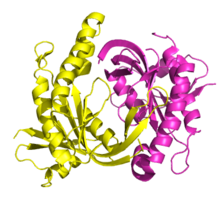
Back غوانيلات سيكلاز Arabic Guanylátcykláza Czech Guanylylcyclasen German Guanylate cyclase French Guanilát-cikláz Hungarian Guanilato ciclasi Italian グアニル酸シクラーゼ Japanese Cyklaza guanylowa Polish Guanilatna ciklaza SH Guanilatna ciklaza Serbian
| Guanylate cyclase | |||||||||
|---|---|---|---|---|---|---|---|---|---|
 | |||||||||
| Identifiers | |||||||||
| EC no. | 4.6.1.2 | ||||||||
| CAS no. | 9054-75-5 | ||||||||
| Databases | |||||||||
| IntEnz | IntEnz view | ||||||||
| BRENDA | BRENDA entry | ||||||||
| ExPASy | NiceZyme view | ||||||||
| KEGG | KEGG entry | ||||||||
| MetaCyc | metabolic pathway | ||||||||
| PRIAM | profile | ||||||||
| PDB structures | RCSB PDB PDBe PDBsum | ||||||||
| Gene Ontology | AmiGO / QuickGO | ||||||||
| |||||||||
Guanylate cyclase (EC 4.6.1.2, also known as guanyl cyclase, guanylyl cyclase, or GC; systematic name GTP diphosphate-lyase (cyclizing; 3′,5′-cyclic-GMP-forming)) is a lyase enzyme that converts guanosine triphosphate (GTP) to cyclic guanosine monophosphate (cGMP) and pyrophosphate:[1]
- GTP = 3′,5′-cyclic GMP + diphosphate
It is often part of the G protein signaling cascade that is activated by low intracellular calcium levels and inhibited by high intracellular calcium levels. In response to calcium levels, guanylate cyclase synthesizes cGMP from GTP. cGMP keeps cGMP-gated channels open, allowing for the entry of calcium into the cell.[2]
Like cAMP, cGMP is an important second messenger that internalizes the message carried by intercellular messengers such as peptide hormones and nitric oxide and can also function as an autocrine signal.[1] Depending on cell type, it can drive adaptive/developmental changes requiring protein synthesis. In smooth muscle, cGMP is the signal for relaxation, and is coupled to many homeostatic mechanisms including regulation of vasodilation, vocal tone, insulin secretion, and peristalsis. Once formed, cGMP can be degraded by phosphodiesterases, which themselves are under different forms of regulation, depending on the tissue.
- ^ a b Martin, Emil; Berka, Vladimir; Tsai, Ah-Lim; Murad, Ferid (2005). "Soluble Guanylyl Cyclase: The Nitric Oxide Receptor". Methods in Enzymology. Vol. 396. Elsevier. pp. 478–492. doi:10.1016/s0076-6879(05)96040-0. ISBN 978-0-12-182801-1. ISSN 0076-6879. PMID 16291255.
Soluble guanylyl cyclase is recognized as the most sensitive physiologic receptor for nitric oxide. Binding of nitric oxide to the heme moiety of the cyclase induces its capacity to synthesize the second messenger cGMP.
- ^ Sakurai K.; Chen J.; Kefalov V. (2011). "Role of guanylate cylcase modulation in mouse cone phototransduction". The Journal of Neuroscience. 31 (22): 7991–8000. doi:10.1523/jneurosci.6650-10.2011. PMC 3124626. PMID 21632921.